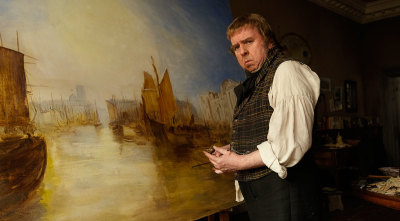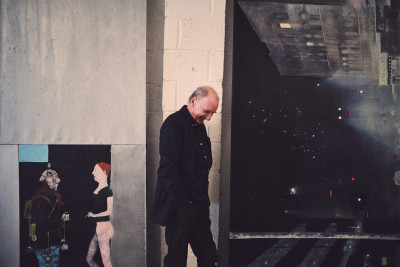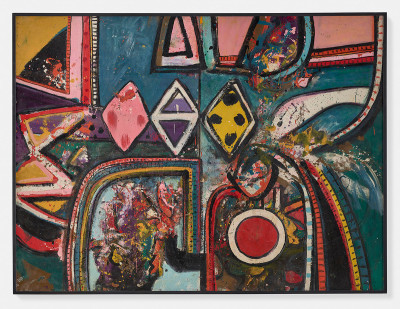Martin Creed: What’s the point of it?
Martin Creed: What’s the point of it?
By Sarah Bolwell
Published 4 February 2014
Deafened by a choir of incessant metronomes, almost decapitated by a huge swinging sign shouting ‘mothers’, nearly floored by a leather sofa blocking the entrance – the first three seconds of the Hayward Gallery’s latest show threatens to overwhelm (and injure).
-
It’s fantastic. Side-stepping the living room furniture, we are met by a grinning Martin Creed. This early self-portrait is like the show - cheeky, challenging, frank, unembarrassed - cocky almost. The Turner Prize-winning artist presents us with a variety of sculptures, installations, paintings and films spanning his career, alongside a number of extravagant new commissions.
-

Martin Creed, Work No. 293, 2003.
‘What’s the Point of It’, Hayward Gallery, 2014, Installation view..
Photo: Linda Nylind..
-
The exhibition unfolds layer by layer, a collage of sights and sounds. In one corner you can hear Creed, like a scolded child, blowing raspberries. His tantalizing snigger unsettles as you walk into the gallery’s conveniences and a huge stack of loo-roll adorns a wall upstairs. It’s funny, but there is far more to the exhibition than toilet humour. Navigating the sculptures and dodging the cacti, what becomes apparent and indeed striking, is the way in which Creed has used the space.
-
Art galleries are just rooms with special lighting and a bit of paint.
Martin Creed
-
The Hayward Gallery is missing several internal walls, allowing us to consider the whole space as one large artwork. ‘What’s the point of it’, Creed’s first major retrospective, is not merely a display of his work. Alongside Hayward Gallery curator Cliff Lauson, Creed has created a diverse environment – a playground – an experience. Installations such as Work No. 1686 - a Ford Focus on top of one of the three sculpture terraces and Work No. 200 Half the air in a given space – an enclosed room full of white balloons are fun and engaging.
-

Martin Creed, Work No. 916, 2008.
‘What’s the Point of It’, Hayward Gallery, 2014, Installation view..
Photo: Linda Nylind..
-
Martin Creed cites Samuel Beckett as one of his most important influences. In much the same way as Beckett, Creed rebuffs labelling. He famously claims not to be an artist at all - that his creative offerings are not in fact works of art, they are simply ‘things’. As Beckett rejected the conventions of theatre, so Creed challenges the conventions of the art establishment - about which he is vociferous, “Art galleries are just rooms with special lighting and a bit of paint.”
-

Martin Creed , Work No 200 , 1998 .
‘What’s the Point of It’, Hayward Gallery, 2014, Installation view..
Photo: Linda Nylind..
-
Creed’s curatorial touches are ubiquitous. He has a distinct hanging style – lower than the norm in both public and commercial galleries - and many of the ropes around the exhibits are missing, sagging or trailing. His is a natural, effortless understanding of the viewer/object dynamic. The connection he establishes with his audience seems confident, but in conversation he admits to suffering from long-standing confidence crashes. He jokes, “One of my tutors once told me, ‘never show people all your work, because at least if they don’t like it they can go home and say ‘well I didn’t like that, but I might like some of their other stuff’.’” However, inquietude is discernable through his cheerful Glaswegian tones, “I try to just do things I can live with and that I can live with having done - I’m always worried I won’t,” he says. The large neon sign proclaiming, ‘Don’t Worry’ (Work No. 890) is a reassuring mantra to himself more than anyone else, perhaps.
-

Martin Creed, Work No. 1636, 2013.
‘What’s the Point of It’, Hayward Gallery, 2014, Installation view..
Photo: Linda Nylind..
-
For a man who’s “plagued by self-doubt” the show is remarkably self-assured. Beckett once said, “The key word is ‘perhaps’”, but ‘What’s the point of it’ is whimsical, warm and a winner - there are no two ways about it.
• ‘Martin Creed: What’s the point of it?’ is at the Hayward Gallery until 27 April 2014.







